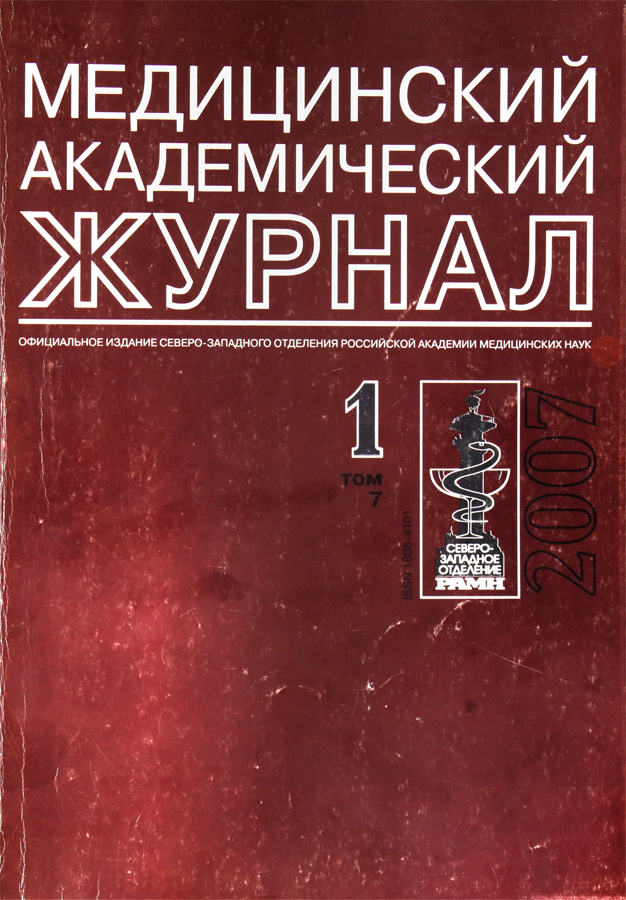Studies of the cerebral blood flow and metabolism in ischemic disease of the brain
- Authors: Khilko V.A.1,2, Tyutin L.A.3, Fadeev N.Р.3, Pozdnyakov А.V.3
-
Affiliations:
- Military Medical Academy
- City Neurosurgical Rsearch and Practice Center at CMPH 2
- Central Research Institute of Roentgenology and Radiology
- Issue: Vol 7, No 1 (2007)
- Pages: 61-65
- Section: Basic clinical manifestations of atherosclerosis
- Published: 15.02.2007
- URL: https://journals.eco-vector.com/MAJ/article/view/692606
- ID: 692606
Cite item
Abstract
Improvement of methods for diagnosis and treatment of ischemic insults is one of the most urgent problems in clinical medicine. It is due to a wide spread and trend to acute stroke (AS). According to WOS data the lethal outcome, occurred as a result of insult, makes the second place in mortality structure not only among old people but among those who are at a working ability age (40-60 y. o.) Besides, inability level in a year after the AS makes 68-82%. In Russia the rate of ischemic insult morbidity reaches 600 cases per 100 000 of citizens and it is yearly increased by 6, 5%. Success in surgical treatment for this disease depends on detection of indications for surgical intervention which are featured by new technique facilities for determining volumetric cerebral blood flow and metabolism in the area of ischemic strokes. Methods of radionuclide diagnosis were used: single photon emission CT, positron emission tomography and proton magnetic resonance spectroscopy. Based on these studies 4 areas of disorders in regional blood flow and metabolism were revealed.
About the authors
V. A. Khilko
Military Medical Academy; City Neurosurgical Rsearch and Practice Center at CMPH 2
Email: shabanov@mail.rcom.ru
академик РАМН
Russian Federation, Saint Petersburg; Saint PetersburgL. A. Tyutin
Central Research Institute of Roentgenology and Radiology
Email: shabanov@mail.rcom.ru
Russian Federation, Saint Petersburg
N. Р. Fadeev
Central Research Institute of Roentgenology and Radiology
Author for correspondence.
Email: shabanov@mail.rcom.ru
Russian Federation, Saint Petersburg
А. V. Pozdnyakov
Central Research Institute of Roentgenology and Radiology
Email: shabanov@mail.rcom.ru
Russian Federation, Saint Petersburg
References
- Бритов А. Н, Гундарев И. А., Константинов Е. Н. Особенности мозгового кровообращения при артериальной гипертонии // Тер. архив. 1987. Т. 59. № 9. С. 12-16.
- Верещагин Н. В., Борисенко В. В., Власенко А. Г. Мозговое кровообращение. Современные методы исследования в клинической неврологии. М.: Медицина, 1993. 208 с.
- Виленский Б. С. Инсульт: профилактика, диагностика и лечение. СПб., 1999. 336 с.
- Вознюк И. А. Церебральная гемодинамика у лиц с начальными проявлениями недостаточности кровоснабжения мозга: Автореф. дис. ... канд. мед. наук. СПб., 1994.
- Вордлоу Д. Нейровизуализация при инсульте: достижения и преимущества // Ж. неврол. и психиатр. 2000. № 8. С. 35-37.
- Тютин Л. А., Поздняков А. В., Брежнев С. А. и др. Протонная магнитно-резонансная спектроскопия в диагностике нарушений мозгового кровообращения // Terra Medica. 2000. № 4. С. 11-12.
- Barest G. D., Sorensen A. G., Gonsalez R. G. Magnetic resonance imaging of cerebral infarctio // Top. Magn. Reson. Imaging. 1998. Vol. 9. № 4. P. 199-207.
- Baron J. Mapping the ishemic penubra with PET: implications for acute stroke treatment // Cerebrovasc. Dis. 1999. Vol. 9. № 4. P 193-201.
- Wardlaw J. M., Marshall I., Wild J. et al. Studies of acute ischemic stroke with proton magnetic resonance spectroscopy: relation between time from onset, neurological deficit, metabolities in the infarct, blood flow and clinical outcome // Stroke. 1998. Vol. 29. № 8. P. 1618-1624.
Supplementary files






